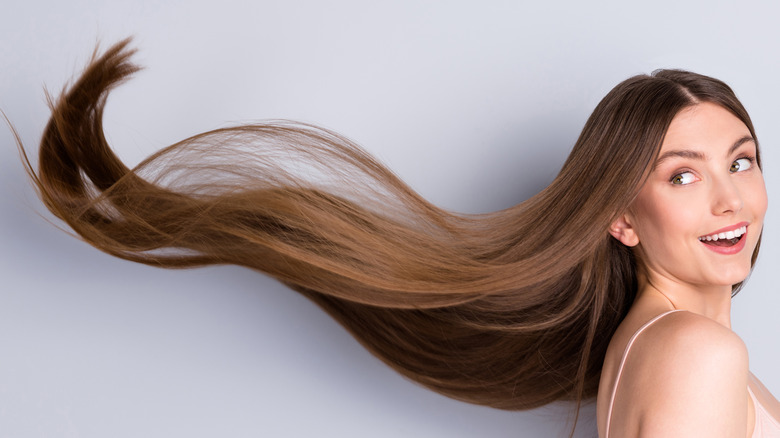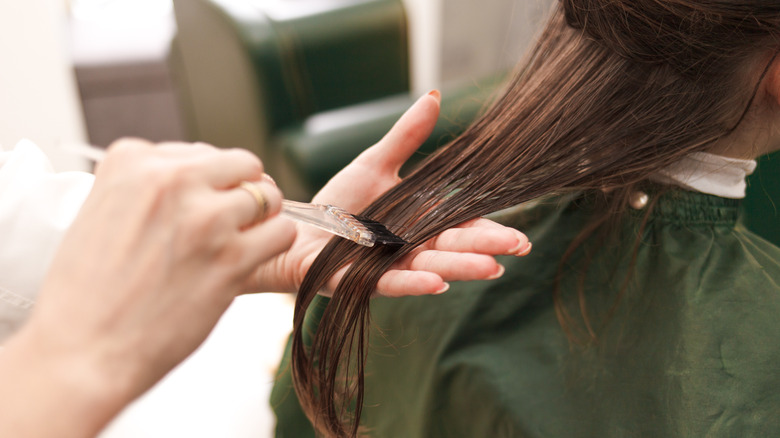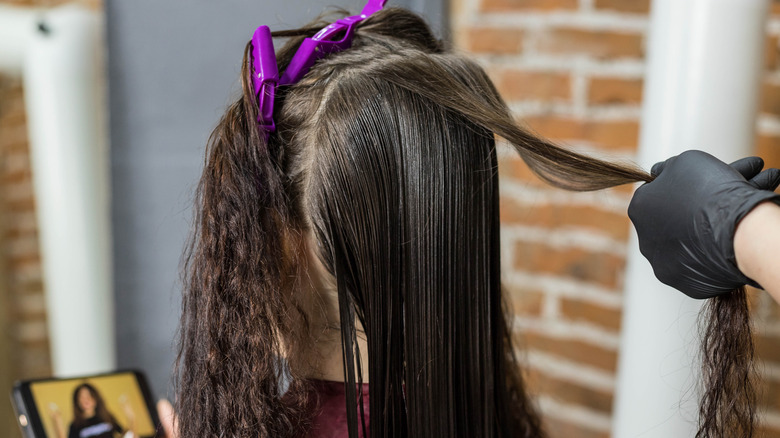The Difference Between Hair Botox And Keratin Treatments
In today's world, the search for silky smooth hair may seem confusing when it comes to which treatments and products to choose. Two of the options on the market are hair botox and keratin treatments, but what's the difference between the two? Healthline reports that both treatments can renew hair and deep condition, but depending on your hair type and desired results, one may be more preferential over the other.
The quest for treatments that can renew hair to a healthy, luscious state isn't just a modern phenomenon. The Smithsonian Institute has a collection of hair products from the 19th and early 20th centuries that advertise results of youthful, thick hair while repairing brittle, dry hair. Products for straightening hair began to appear in the 1900s, and both naturally-derived products and chemical-based treatment options became available. Many oils and leave-in items also became common treatments. Today, the availability of choices for achieving soft, shiny locks has evolved to include proven methods for strengthening hair and making it healthy, utilizing both natural and artificial ingredients.
Whether using at-home kits or scheduling an appointment at your local salon, hair botox and keratin treatments are two modern treatments for rejuvenating hair (per Healthline). Both provide the benefits of smoothing hair, but there are some key differences between the two treatments when it comes to application, ingredients, and how long results can last.
Hair botox is chemical-free
Unlike its namesake, hair botox doesn't actually contain botulinum toxin, the compound found in the Botox treatments used to decrease the appearance of wrinkles on the skin (via The Healthy). Also unlike traditional Botox, hair botox doesn't involve needles. Instead, the term hair botox comes from the rejuvenating results the treatment provides to hair, which include hydrating, moisturizing, and smoothing locks. Hair botox is a deep conditioning treatment that softens and smoothes strands of hair. While there are no particular ingredients required to be in hair botox, the solution must be completely chemical-free to be considered a hair botox treatment. To apply the treatment, a syringe is typically used to place the solution near the scalp and extended throughout the hair from roots to ends. Afterward, it is allowed to sit for approximately 20 to 90 minutes, reports Healthline.
The purpose of hair botox is to add shine, condition, and reduce frizz (per Byrdie). To do this, ingredients found in hair botox treatments often include caviar oil, vitamin E, B5, antioxidants, and collagen complex (per Healthline). It's primarily the collagen that rejuvenates hair through the deep conditioning process of hair botox. The benefits of hair botox last for up to three months. The treatment can also rid hair of free radicals through the use of vitamins in hair botox solutions. While hair botox is considered safe for all hair types and the benefits are substantial, the treatment generally will not straighten hair.
Keratin treatments straighten hair
If your goal is straighter hair, a keratin treatment is more likely to be a better option than hair botox, according to Healthline. Keratin treatments strengthen hair by fortifying strands, which culminates in hair growing faster since the ends won't break as easily. Terms used interchangeably to reference keratin treatments include Brazilian blowout and Brazilian keratin treatment.
While hair botox is required to be chemical-free, keratin treatments often include the chemical formaldehyde, which is used to break down the bonds in hair to straighten strands, says Allure. Not all keratin treatments include formaldehyde, but it's important to check the ingredients in a treatment solution if you're hoping to stay chemical-free. If your intention is to straighten hair, a formaldehyde-free keratin treatment likely won't produce desired results. Keratin treatments free from formaldehyde will deep condition and give hair a smooth shine, but it's formaldehyde that creates the straightening effect.
The results from a keratin treatment can last up to six months (via Healthline). Keratin treatments can be especially helpful for managing hair that is naturally thick or frizzy. Keratin treatments can also help cut down on the amount of time it takes for hair to dry, which may give you the added benefit of taking pressure off of your morning routine and allowing you to hit the snooze button. Spending less time blow drying your hair reduces the amount of heat your hair is ultimately exposed to, thus adding to the overall health of your locks.



